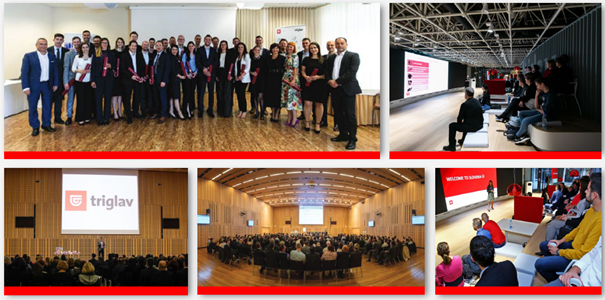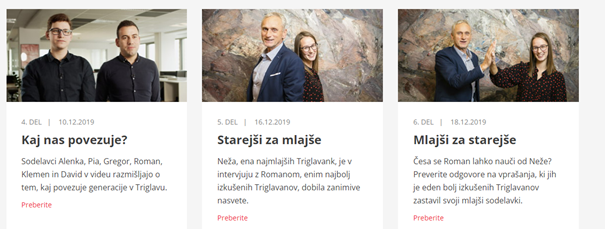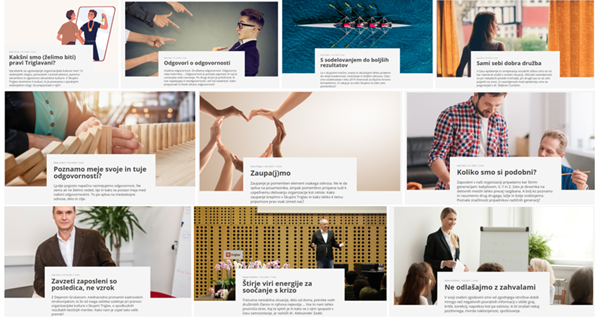
Introduction
Zavarovalnica Triglav is the largest Slovenian insurance company and the controlling company of the Triglav Group and is the leading insurance and financial group in Slovenia and the Adria region. The group operates in seven markets in six countries and more internationally through partnerships with companies for insurance mediation, representation and reinsurance. With its knowledge, experience and financial strength, it has been justifying the trust of customers and other stakeholders for more than 120 years. The key pillars of its business are insurance and asset management. The main values of the company are responsiveness, simplicity and reliability. Its vision is to set the standard for an exceptional user experience – always and everywhere. With a sustainable orientation of operations, it is a development-oriented environment for employees, connected with partners and a stable, safe and profitable investment for investors.
As part of the development of the organizational culture, they continue to create a highly successful and service-oriented organizational culture that supports strategic business directions, and an organizational environment that encourages healthy, satisfied and engaged employees to develop skills and competencies to successfully achieve goals. Special emphasis is placed on teamwork, intergenerational cooperation, a healthy way of life and work, and orientation towards relationships.
Basic Information
| Name of Organization: | Zavarovalnica Triglav, d.d. |
|---|---|
| Company Size: | > 250 |
| Location: | Ljubljana, Republic Slovenia |
| Industry: | Insurance |
| Form of the Entity: | Commercial company |
Work Story
Already ten years ago, personnel projections showed them that the share of older employees will increase significantly in the next period. This finding, while simultaneously taking into account the demographic situation in Slovenia, encouraged them to act quickly. Their goal was to ensure a sufficient number of professionally trained and competent employees, digitize and optimize work processes, raise the digital competencies of employees, improve the reputation of the employer brand and change the organizational culture so that it is also favorable to age diversity. They started preparing older employees for changes and encouraging them to lifelong learning in order to prevent early cognitive retirement and increase motivation for work. Today, even due to the change in pension legislation, older employees remain active performers of work processes for a longer period. As an employer, they encourage work in age-mixed work groups, thereby providing a suitable environment for the development of mutual mentoring and preventing older employees from losing the organizational knowledge they have acquired over many years of professional career when they leave.
They started the work on a project basis. In the beginning, they devoted a lot of time to informing employees, encouraging them to accept changes and lifelong learning, and taking care of maintaining their psychophysical condition. In the following, in cooperation with the Institute of dr. Anton Trstenjak developed and implemented an education program for senior employees and managers. Managers were encouraged to actively involve older employees, to introduce changes in work organization and to create age-mixed work groups. Today, the majority of older employees remain satisfied and active performers of work tasks until they meet the conditions for retirement, and some even longer.
Useful Insights
Even well-planned and implemented activities in the adaptation process of older employees do not guarantee quick changes. The first results are noticeable after several years. In the beginning, they were faced with a reserved response both from senior employees and managers. Their older employees, despite being aware of the changes, still too often tried to leave quickly, and their interest in learning and continuing to work grew slowly. Managers also needed support and constant encouragement in involving the elderly, introducing new ways of working and adapting the work environment and work processes.
Therefore, consistent and comprehensive communication with seniors and leaders is extremely important. Since progress is minimal in the first stages of the project, there is a risk of a decline in motivation to continue work even in a professional team. It is extremely important that the project manager gets the support of top management to continuously monitor the process, intensify activities when there is a standstill, take care of the team’s motivation about the activities carried out, inform all key stakeholders and promote the important achievements of older employees and age-mixed work groups.
Ideas for Reflection
Above all, they must not skimp on the time they devote to communication and promotion of work in age-mixed work groups. In such forms of work, everyone, young people, is gaining. i. g. the tacit knowledge of the seniors, which would otherwise be lost with their departure, and the seniors the digital knowledge and skills that younger colleagues can provide them.
Keywords
safer future for all stakeholders





 AGEADAPT project has been funded by the European Union, with the reference number 2021-1-DE02-KA220-ADU-000033518. Views and opinions expressed are however those of the author(s) only and do not necessarily reflect those of the European Union or the European Education and Culture Executive Agency (EACEA). Neither the European Union nor EACEA can be held responsible for them.
AGEADAPT project has been funded by the European Union, with the reference number 2021-1-DE02-KA220-ADU-000033518. Views and opinions expressed are however those of the author(s) only and do not necessarily reflect those of the European Union or the European Education and Culture Executive Agency (EACEA). Neither the European Union nor EACEA can be held responsible for them.